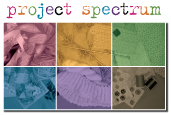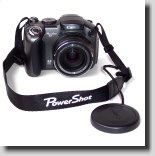
When I was working on the Encased project, I felted several of the floral rounds in assorted colors. Here’s another little project using these versatile flower shapes.
First, you will need to felt a floral round in any color you like. Cut it out of the organza and match it up with some colorful rick rack.

Felted Floral Round
Turn your floral round to the back side, and dab some fabric glue around the edges.

Dab Fabric Glue Around Edge of Back Side
Position the rick rack so that the rounded points form the look of petals.

Glue Rick Rack to Form Petals
Your flower/flowers should look something like this when you are finished.

Completed Flowers
To create leaves, fold some green rick rack at a point as shown.

Step One of Rick Rack Leaves
Now wrap the rick rack back and forth around itself. The inner loops will lock together. Trim off at the length you would like your leaves.

Step Two of Rick Rack Leaves
Cut a piece of fabric whatever size you would like you project to be. The size will depend upon what you are making. Stabilize it with a heavy fusible stabilizer or interfacing. Alternately, you could sandwich it with batting and quilt it.
Cut a piece of the colorful rick rack to form a stem. Dab it in a few places on the back side with some fabric glue, and position it on the front of your project. Dab the raw edges of the leaves with fabric glue and position the ends under the rick rack.

Secure Stem and Leaves
Secure the outer edges of the leaves with beads.

Leaf Beading
Embellish the rick rack stem with seed beads at each point.

Seed Bead Embellishment
Position your flower at the top of the stem. Secure it will a little fabric glue in the center back to keep it from shifting. Embellish the petal points with bugle beads.

Bugle Bead Petals
I’m sure you’ll find all sorts of creative ways to embellish these little felted flower. Have fun!
~~~~~~~~~~~~~~~~~~~~~~
Rene
Time Treasured


















































































































